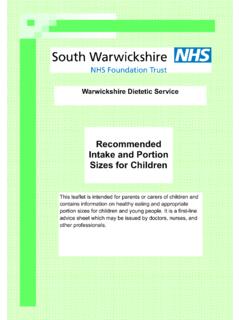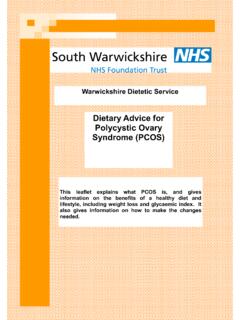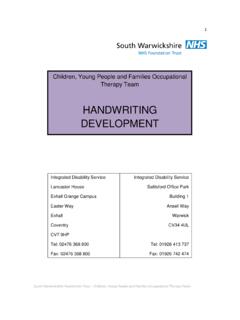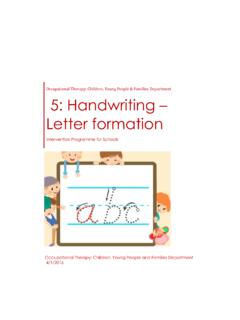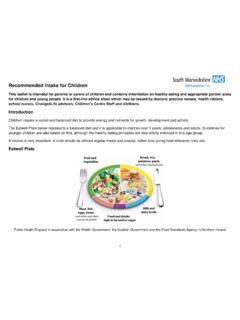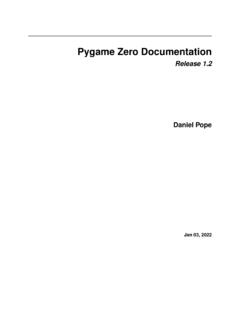Transcription of 1: Foundation Skills
1 Occupational Therapy: Children, Young People & Families Department 1: Foundation Skills Intervention Programme for Schools Occupational Therapy: Children, Young People & Families Department 1/1/2016 Foundation Skills 02/2016 Intervention programme 1: Foundation SKILLSAims: To develop the Foundation Skills for fine motor Skills : hip and trunk stability, shoulder girdle stability, body awareness, dissociation of upper limb movements, visual tracking, hand awareness/movement crossing midline, motor planning, sensory Skills , visual-motor integration, balance. Functional outcomes: Moving around the classroom, being able to sit ready for writing, getting changed for PE, pre-writing readiness. Introduction This programme has been designed to develop the Foundation Skills needed for fine motor Skills , including body awareness, strength, stability and balance, and visual Skills . The plan consists of treatment sessions designed to be delivered in small groups, three times a week, for approximately 20 minutes, over a half term.
2 The sessions have been designed in a developmental order; that is, working on the easier Skills first and then building gradually to the more difficult Skills . Each session starts with a warm-up, which works on some gross motor Skills and some sensory Skills such as body awareness and motor planning. The main activities then work on basic fine motor Skills , including hand strength. You can do more than the suggested sessions: a daily warm-up would benefit the whole class. This programme is an ideal follow-on from a gross motor activity group or programme, such as If you would like more information on , contact the Children s Physiotherapy department on 01926 413737. Foundation Skills 02/2016 Before you - Complete the Which Programme? Fine Motor Skills screening form to make sure you are choosing the appropriate programme for the child - Fill in the Baseline Assessment (see back of booklet) to get an idea of how the child is performing now.
3 - To fill in the Session Completion (see back of booklet) list to keep track of which sessions the child has completed. - To re-do the Baseline Assessment at the end to see how much progress the child has made. - Once the child has successfully completed this programme, they can move on to Intervention Programme 2. If they still need to consolidate the Skills in this programme, it can be repeated. Further information You can find more information and resources on our website: Foundation Skills 02/2016 Examples of how activities work on different Skills Perceptual and planning Skill Example activity Motor planning: The ability to perform a novel motor task and transfer learned movement patterns to a new task. Walk the line Mirror mirror Obstacle course Visual Skills : Ability to see clearly and control eye movements Marble roll Balloon Bash Throwing & catching Midline crossing: the ability to cross an imaginary line through the centre of the body, for example when writing from left to right across the page Lazy 8s Cross-marching Pass the ball Movement Skills Skill Example activity Stability: The trunk and shoulders form a stable base for precision movements of the fingers and hand Wall push-ups Animal walks Balancing Mobility: The fingers and hand perform the fine movements Ball Walks Playdough Pegs Dissociation: The hand and fingers need to move independently of the arm and trunk Arm warm-ups flappy football Finger high-fives Bimanual hand use: Using both hands in a lead-assist manner.
4 One hand assists ( stabilises paper) while the other hand performs the skilled task ( cutting with scissors) Nuts and Bolts Drawing round hand Foundation Skills 02/2016 Sensory Skills Skill Example activity Sense of body position (proprioception): Being able to feel your body position. Push-ups Animal walks Jumping Sense of body movement (kinesthesia): The ability to feel one s own body as it moves through space. Mirror mirror Sky drawing Vestibular: Based on information from our inner ear. Important for balance, movement sense and knowing where our body is in space. Balancing on one leg Tummy skittles Jumping Tactile discrimination: The ability to feel and discriminate by touch. Feely box Playdough treasure hunt Sand drawing Foundation Skills 02/2016 Overview Week 1 Warm up Main activities Session 1: Beanbag crawl; Arm Wake-up Walk the Line; Playdough Snakes Group colouring Session 2: Log Rolling; Arm Wake-up Feely Box Ball roll Bubble Pop Session 3: Superman and Hedgehog; Arm Wake-up Lazy 8s Playdough pinch pot Skydrawing Week 2 Warm up Main activities Session 1: Rocking horse and giraffe; Arm Wake-up Playdough pizza flappy Football Mirror Mirror Session 2: Tummy Skittles, Arm Wake-up Sky Drawing Taptastic Beanbag target throw Session 3: Superman & Hedgehog; Sideways push-ups; Arm Wake-up Playdough nest Group colouring Balloon Bash Week 3 Warm up Main activities Session 1: Crab walk; Arm Wake-up Playdough sausage and beans Rainbow Drawing Target throw Session 2: Animal walks.
5 Arm Wake-up Nuts and Bolts Skittles Sand drawing Session 3: Ball Wall Walk, Arm Wake-up Playdough dinosaurs Hungy Horace Marble roll Week 4 Warm up Main activities Session 1: Jump around; Arm Wake-up Playdough treasure hunt Tower building Under/over/round ball pass Session 2: Stand up/sit down; Arm Wake-up Circles Feely box Marble grab Session 3: Cross marching; Reciprocal skipping; Arm Wake-up Playdough Minions Hungry Horace Egg and Spoon Race Foundation Skills 02/2016 Week 5 Warm up Main activities Session 1: Balance; Wall push-ups; Arm Wake-up Playdough Shapes Sand drawing Egg box sorting Session 2: Tightrope walking; Arm Wake-up Clothes Pegs Finger High-fives String shapes Session 3: Stepping stones; Wall Angels; Arm Wake-up Playdough Shapes Hungry Horace Guess the String Shape Week 6 Warm up Main activities Session 1: Bird-dog; Push ups; Arm Wake-up Playdough marble maze Controlled colouring Feely box Session 2: Bird-dog; Crazy catch; Arm Wake-up Playdough food party Pour and stop Fast Actions Session 3: Bird-dog; Body ball walk; Arm Wake-up Hand Drawing Pegs Statues Foundation Skills 02/2016 Some technique tips!
6 This is a good position for all the pushing exercises. Elbows bent, and arms held away from body. Don t let your child hold his elbows tightly against his body like this. He won t be using his shoulder girdle muscles if he does this. This is also not a good position as his elbows are elevated and his shoulder girdle muscles won t work properly in this position. Foundation Skills 02/2016 Week 1: Session 1 Resources: Tape or string Beanbags or small toys Pieces of card/paper and a marker pen Playdough Bubbles Large piece of paper Wax crayon stubs Warm-up: Beanbag crawl Get onto all fours. Now turn the head to one side and place a beanbag between the chin and the shoulder. Keeping the beanbag in place, race across the room! Make sure you do left and right sides. Arm wake-ups Shrug your shoulders to your ears then back down. Touch the sky, keeping your shoulders down. Touch your shoulders hand to same shoulder Touch your shoulders hand to opposite shoulder Push down on the desk Hold your hands out, palm up, then palm down Push palms together Pull hands apart Link your hands together and circle your wrists, one way then the other Make a fist, thumbs up and give them a wiggle Touch each finger to your thumb, one at a time, making a big circle.
7 Shake your hands out you re ready to begin! Main activities: Walk the line Make a path along the floor using tape or string. Use straight, curved and diagonal lines. Walk with or without shoes. The children can walk, run, crawl or roll, or drive a toy car along it. They can mark the start and finish of the lines with a beanbag or toy. Draw a design on a piece of card and see if the children can copy this with the string. Foundation Skills 02/2016 Play-dough snakes Use both hands together to gradually roll an even-sized length of dough. Ensure the body remains still, the shoulders relaxed and the arms move from the shoulders. Isolate the thumb and each individual finger consecutively to press down on the snake of dough; first one hand then the other. Pinch/squeeze the snake between thumb and individual finger tips consecutively, one hand and then the other. Roll the snake into a ball on the tabletop with one hand. Pick up and squeeze as hard as possible with one hand.
8 Roll dough into a ball between two hands and squeeze as hard as possible using the other hand. Group colouring Kneeling on the floor or standing around a table, place a large piece of paper in the middle. It will probably be helpful to tape it down. Using wax crayon stubs, everyone helps to cover the paper in colourful scribbles. The children will need to be aware of others around them. Wax crayon stubs will help with pincer grip technique. You can doodle an abstract shape, as in the example, to colour in, or enlarge a colouring worksheet onto several sheets of paper. Why not try dipping toy trains or cars in paint and driving them around the large sheet of paper to make patterns? Foundation Skills 02/2016 Week 1: Session 2 Resources: Balls (football sized and smaller) Skittles (or empty cereal boxes/ kitchen roll tubes) Marbles or small balls and paper cups A tub filled with rice, lentils or play sand. A selection of small objects to hide in the box.
9 Bubbles Warm-up: Log rolling Lie down with your arms stretched above your head. Roll over and over to the right and then the left. Try to keep in a straight line. Make it more difficult by holding a ball while you do this. Roll towards a target, such as some skittles and try to knock them over! Arm Wake-ups Shrug your shoulders to your ears then back down. Touch the sky, keeping your shoulders down. Touch your shoulders hand to same shoulder Touch your shoulders hand to opposite shoulder Push down on the desk Hold your hands out, palm up, then palm down Push palms together Pull hands apart Link your hands together and circle your wrists, one way then the other Make a fist, thumbs up and give them a wiggle Touch each finger to your thumb, one at a time, making a big circle. Shake your hands out you re ready to begin! Main activities: Feely box Fill a large container with rice, lentils or play sand. Hide some different everyday items in there: cotton reels, a key, a pencil, a Lego block, etc.
10 Use geometric shapes or letter shapes if you have them. The children take it in turns to reach in to the box and find an object. See if they can tell what it is without looking. Foundation Skills 02/2016 Ball roll Sitting on the floor in a circle, roll the ball to each other. If a large ball is too easy, try a smaller ball. If that s too easy, try a marble or try catching the ball under a cup. Bubble pop Blow some bubbles and see if the children can pop them using just their index finger. How many can they pop? Foundation Skills 02/2016 Week 1: Session 3 Resources: Mats A whiteboard/ chalkboard/ large piece of paper on the wall Some chunky marker pens, crayons or chalks Playdough (and some plastic pegs or beads) Warm-up: Superman Lie on your tummy, with arms straight out in front. Now lift arms, chest and head off the floor. Relax back down. Next, lift the legs don t bend at the knee! so the thighs lift off the floor. Relax back down.
